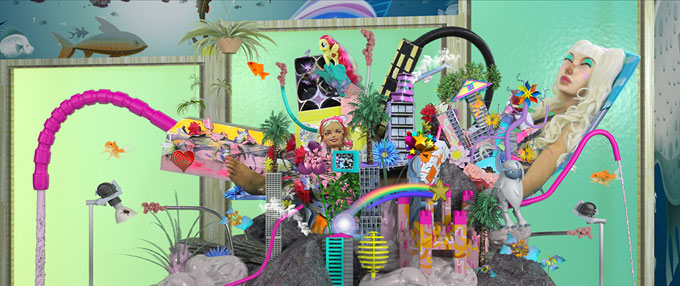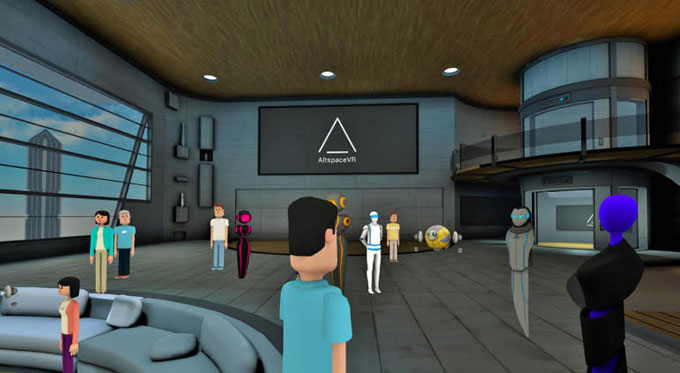
Katie Torn, Breathe Deep, 2014. Still from animation. Courtesy of the artist.
It’s a great time to be in the virtual-reality business. While Facebook, Microsoft, Samsung and Google are investing billions in hardware, we’re experiencing a content gold rush.
But many people making VR content today seem to think the endgame is creating an experience that fully conveys a place – a trip to Mars or the Grand Canyon. “What if you could travel to faraway lands in a heartbeat?” asks an introductory video produced by the makers of Oculus Rift – a VR headset – as the camera flits from a stilt house in Southeast Asia to an African safari.
Such experiences are impressive, but they will never truly feel real until they can be shared, because reality is about more than places. It’s about people.
A story: I once met a young man in VR named Eric. I spotted him standing alone at the edge of a digitally generated cliff. “Admiring the view?” I asked, being goofy. He looked me over wordlessly. We stood beside one another in charged silence before I tried again: “Is this as far as you can go?” Before he could answer, I nosed closer to the cliff, then slid down its face. I found the edge of the world, where the textured ground ended and a yawning polygon void began. He followed.
We were in AltspaceVR, a Second Life-like virtual world that is one of several social platforms available to early adopters of VR with Oculus Rifts or competing headsets HTC Vives and Samsung Gear VRs. As rendered clouds slid past, he told me about Oklahoma City, where he lives. He was 15. I was wearing the body of a robot: a metal spiral with a featureless head, like the dot of an “i”.
“I’m probably the first person in Oklahoma to get virtual reality,” he told me, in a tone that conveyed both pride and great, inconsolable loneliness.

Still from AltspaceVR interface, courtesy of AltspaceVR.
After I peeled off my headset, I was alone in my living room, but the conversation hung onto me for days. Talking to Eric, my body had reacted as though I was having a conversation with a lonely teen, all sympathetic nerves, because I was having a conversation with a lonely teen. I felt something, and I felt for him. AltspaceVR isn’t a particularly convincing environment – the avatars are blocky, the scenes roughly sketched – but Eric’s crushing adolescent awkwardness made virtual reality feel truly real.
That human presence is key is not a new observation. Back in the dial-up days, when “cyberspace” was a neologism borrowed from science fiction, a group of academics descended on the University of Texas at Austin for the First International Conference on Cyberspace. Opinions on the subject, in 1990, were colorful. One attendee described cyberspace as “poetry inhabited,” saying that to “navigate through it is to become a leaf on the wind of a dream.”
We’re still a long way from virtual worlds that can interact with players with anything near the unpredictability and candor of another human being.
This made it all the more surprising when two programmers from Lucasfilm – Chip Morningstar and F Randall Farmer – took their turn to speak. The pair had built a game called Habitat, a primitive version of the VR hangout where I met Eric: a cartoon environment where networked players chatted in real time, their words popping up as comic-book speech bubbles above the heads of their avatars.
Habitat ran on computers hardly more powerful than pocket calculators, but its players waged wars, fell in love, made political moves – even started religions. It became a real community; half of the players of Habitat considered their avatars to be representations of themselves rather than puppets they controlled. Morningstar and Farmer could only draw one conclusion from the experience: virtual reality is made of people.
Twenty-six years later, the logic holds. We’re still a long way from virtual worlds that can interact with players with anything near the unpredictability and candor of another human being. Interacting with people is still more visceral than anything graphics, stories or gameplay can achieve alone. There’s no sense in trying to work against this. Working with it, as a design strategy, by making space for real social interactions within virtual environments, is extraordinarily effective. Forget real-looking; let’s try for real-feeling.
Morningstar and Farmer wrote that “Cyberspace may indeed change humanity, but only if it begins with humanity as it really is.” I’d argue the same for virtual reality.
I may never find Eric again, but I think of him every time I head into a VR world. His awkwardness charged the air: when I stood next to him, I felt aware of our closeness, despite the 1,300 miles separating our physical bodies. For the length of our conversation, the electric strangeness of human proximity made everything else irrelevant. I was immersed.
This piece, commissioned by Creative Time Reports, has also been published by The Guardian.

